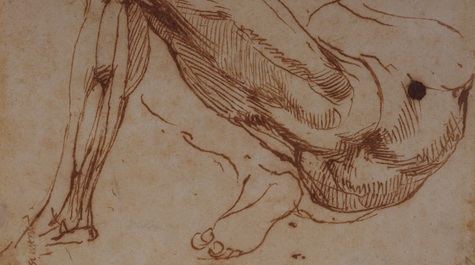Muscarelle featured in Wall Street Journal article
The March 17 article, entitled "The Frugal Genius," discusses Michelangelo's process, which often involved reusing materials.
"The 12 drawings by Michelangelo on loan from the Casa Buonarroti in Florence and on view here in the Muscarelle Museum represent a rare opportunity to see Michelangelo in his workaday mode of production, jotting down visual ideas in a hurry alongside poetic verses or assorted notes," according to the article.
The exhibit consists of drawings, archival pages, and engravings on loan from the finest collection of Michelangelo drawings and the ancestral home, the Casa Buonarroti in Florence, Italy. Combined with Old Master drawings from the collection of the Museum, the exhibition depicts and illustrates Michelangelo's concept and philosophy that architecture was anatomical in a way that has never been done before. The exhibition explores new research in Michelangelo architectural studies, includes digital reconstructions of buildings never before believed to be influenced by Michelangelo, and lectures by world-renowned scholars on Michelangelo.
The Muscarelle Museum of Art will be the only U.S. venue for Michelangelo's treasured drawings on view from Feb. 6 to April 11.
Michelangelo Buonarroti (1475-1564) had a vision of architecture that was rooted in the understanding of the human body, and his theory of anatomy was articulated in the study and design of architecture. While most Renaissance architects treated the human body as analogy, Michelangelo, a supreme master of the human form, took the comparison further. He viewed anatomy-muscles, nerves, and human proportions-as metaphors for the active elements of architecture. A master draftsman, his design principles were articulated in remarkable sketches. Michelangelo's emphasis on the body in his vision and theory of architecture was unprecedented. He saw it all intertwined as life.
Scholars have always questioned whether or not Michelangelo studied anatomy. He did in several ways. He conducted studies of classical antiquities and the many human forms available to him in ancient sculptures. More importantly, when he was sixteen years old and a guest at the convent church of Santo Spirito on the south-side of the Arno River in Florence, he dissected corpses from the convent hospital. Besides making drawings of dissections, Michelangelo also studied and drew from the human model. From a very young and influential age, Michelangelo actively developed his concept of architecture as anatomy.
This exhibition is curated by the Muscarelle Museum of Art as is the production of the catalogue. The show is organized in Italy by Contemporanea Progetti from the generous loans of the works of art from the Fondazione Casa Buonarroti in Florence upon the authority of the Soprintendenza per i Beni Artistici e Storici in Florence and the Ministero per i Beni e le Attività Culturali of Italy in Rome.
 Skip to main content
Skip to main content


